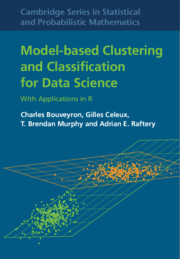Crossref Citations
This Book has been
cited by the following publications. This list is generated based on data provided by Crossref.
Harada, Daisuke
Asanoi, Hidetsugu
Noto, Takahisa
and
Takagawa, Junya
2020.
Different Pathophysiology and Outcomes of Heart Failure With Preserved Ejection Fraction Stratified by K-Means Clustering.
Frontiers in Cardiovascular Medicine,
Vol. 7,
Issue. ,
Kalmin, O. V.
and
Kalmin, O. O.
2020.
Mathematical Modeling of Morphometric Parameters of Thyroid Gland Structure.
p.
1.
Lazic, Stanley E
and
Williams, Dominic P
2020.
Improving drug safety predictions by reducing poor analytical practices.
Toxicology Research and Application,
Vol. 4,
Issue. ,
p.
239784732097863.
Jiang, Liupeng
Jiang, He
and
Wang, Harry Haoxiang
2020.
Soft computing model using cluster-PCA in port model for throughput forecasting.
Soft Computing,
Vol. 24,
Issue. 18,
p.
14167.
Giordani, Paolo
Ferraro, Maria Brigida
and
Martella, Francesca
2020.
An Introduction to Clustering with R.
Vol. 1,
Issue. ,
p.
291.
Zagalo, Kevin
Cucu-Grosjean, Liliana
and
Bar-Hen, Avner
2020.
Identification of execution modes for real-time systems using cluster analysis.
p.
1.
Pradana, I Gusti Made Teddy
and
Djatna, Taufik
2020.
A Design of Traceability System in Coffee Supply Chain based on Hierarchical Cluster Analysis Approach.
p.
1.
Schmutz, Amandine
Jacques, Julien
Bouveyron, Charles
Chèze, Laurence
and
Martin, Pauline
2020.
Clustering multivariate functional data in group-specific functional subspaces.
Computational Statistics,
Vol. 35,
Issue. 3,
p.
1101.
Giordani, Paolo
Ferraro, Maria Brigida
and
Martella, Francesca
2020.
An Introduction to Clustering with R.
Vol. 1,
Issue. ,
p.
215.
Lian, Qiuyu
Xin, Hongyi
Ma, Jianzhu
Konnikova, Liza
Chen, Wei
Gu, Jin
and
Chen, Kong
2020.
Artificial-cell-type aware cell-type classification in CITE-seq.
Bioinformatics,
Vol. 36,
Issue. Supplement_1,
p.
i542.
Waggoner, Philip D.
2020.
Unsupervised Machine Learning for Clustering in Political and Social Research.
Véstias, Mário P.
2020.
Smart Systems Design, Applications, and Challenges.
p.
23.
Ng, Tin Lok James
and
Murphy, Thomas Brendan
2021.
Model-based Clustering of Count Processes.
Journal of Classification,
Vol. 38,
Issue. 2,
p.
188.
Boujibar, Asmaa
Howell, Samantha
Zhang, Shuang
Hystad, Grethe
Prabhu, Anirudh
Liu, Nan
Stephan, Thomas
Narkar, Shweta
Eleish, Ahmed
Morrison, Shaunna M.
Hazen, Robert M.
and
Nittler, Larry R.
2021.
Cluster Analysis of Presolar Silicon Carbide Grains: Evaluation of Their Classification and Astrophysical Implications.
The Astrophysical Journal Letters,
Vol. 907,
Issue. 2,
p.
L39.
Sharma, Sugandha
Mongia, Shweta
Ghosh, Kaushik
Rajpal, Rathang
Yadav, Vishu
Ahuja, Saumya
and
Tripath, Nidhi
2021.
Analysis of AI-driven tools and Impact of Covid-19 on Age: A Case Study for India.
p.
1.
Kißler, Christian
Schwenk, Christin
and
Kuhn, Jörg-Tobias
2021.
Two Dyscalculia Subtypes With Similar, Low Comorbidity Profiles: A Mixture Model Analysis.
Frontiers in Psychology,
Vol. 12,
Issue. ,
王, 琳
2021.
Time Series Clustering with MS-GARCH Mixtures.
Statistics and Application,
Vol. 10,
Issue. 06,
p.
1071.
Kanevski, Mikhail
and
Cordeiro de Amorim, Renato
2021.
Unsupervised learning of Swiss population spatial distribution.
PLOS ONE,
Vol. 16,
Issue. 2,
p.
e0246529.
Fraix-Burnet, D.
Bouveyron, C.
and
Moultaka, J.
2021.
Unsupervised classification of SDSS galaxy spectra.
Astronomy & Astrophysics,
Vol. 649,
Issue. ,
p.
A53.
Mani, A.
2021.
Rough Sets.
Vol. 12872,
Issue. ,
p.
75.





